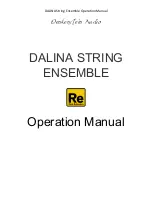
Page 12
LP Stage II User’s Manual - The Components
Page 13
LP Stage II User’s Manual - The Components
B. The Filter Section
Filters are used for adjusting the timbre of an audio signal. Filters modify sound by attenuating some fre-
quencies while allowing others to pass through unaffected. An important term to understand regarding
filters is “Cutoff Frequency”. This is the point at which frequencies begin to be rejected. The LP features
a lowpass filter, which behaves as its name indicates: it allows low frequencies to pass and rejects high
frequencies.
Another important aspect of filters is the cutoff slope. The cutoff slope
defines how well the filter rejects signals above the cutoff frequency.
The cutoff slope is measured in decibels per octave (dB/Octave), and is
specified as a multiple of six. A 6dB/Octave slope (the simplest pos-
sible filter design) exhibits a gentle roll-off with a minimum rejection of
frequencies above the cutoff. By comparison, a 12dB/Octave slope is
twice as steep, and rejects frequencies above the cutoff twice as fast.
An 18dB/Octave slope is steeper still, with a corresponding frequency
rejection. Finally, a 24dB/Octave slope provides the steepest rejection
of frequencies above the cutoff point. The classic Moog filter is a 24dB/
Octave lowpass filter.
The Moog filter also features a parameter called Resonance. This
parameter adds a resonant peak at the cutoff frequency. When the
resonant peak passes through the overtones of the sound being filtered, those overtones are reinforced.
This gives the filter a character that can sound vocal, buzzy or zappy,
depending on how it’s used. When the resonance is turned up past
about 3 o’clock on the analog edit dial, the filter begins to self-oscillate
at the cutoff frequency, producing a sine wave tone.
Other filter section controls include Keyboard Amount (KB AMOUNT),
Envelope Generator Amount (EGR AMNT) and OVERLOAD.
The KB AMOUNT parameter allows you to set the degree to which the filter cutoff frequency tracks the
note that is played. For example, when the KB AMOUNT is set to it’s highest level (100%), the filter cut-
off will rise by an octave each time you play an octave higher on the keyboard. This setting allows you to
maintain a consistent filter tone regardless of whether you play low or high on the keyboard. When the KB
AMOUNT is set to zero, the filter cutoff remains at the value determined by the analog edit control, regard-
less of where you play on the keyboard. This can make the sound less bright as you play higher up on the
keyboard. The KB AMOUNT parameter includes the keyboard GLIDE control signal, which allows the filter
cutoff to follow the glide of the notes being played (when GLIDE is switched ON). Using the KB AMOUNT
control, you can adjust the amount of Glide that will affect the filter cutoff.
The EGR AMNT parameter allows you to set the degree to which the Filter EG affects the filter cutoff
frequency. The EGR AMNT parameter is bi-polar, meaning the Filter EG can affect the filter cutoff either in
a positive or negative way.
A positive amount will cause the Filter EG to raise the cutoff frequency, while a
negative amount will cause the Filter EG to lower the cutoff.
Содержание Little Phatty Stage II
Страница 76: ...Page 78 Little Phatty Stage II Presets ...






































